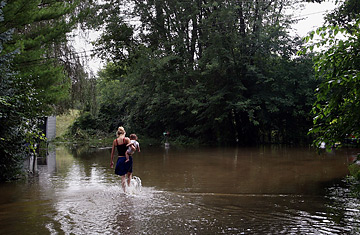
Candace Ross wades through flood water with her niece Savannah near their home August 22, 2007 in Fox Lake, Illinois.
Much of the Midwest is reeling from days of persistent rain and flooding. But there's at least one silver lining — or, perhaps, a golden one: For many on the storm's fringes, even a slight dose of rain is offering relief from the summer's drought.
In a report issued Monday, the U.S. Department of Agriculture's National Agricultural Statistical Service's Des Moines, Iowa, office said recent rains are actually helping corn and soybean crops. "Cooler temperatures associated with rains are helping livestock, though insects continue to be an issue," the report said matter-of-factly.
This is what soybean farmers call the "seed-filling" period. It is perhaps the most critical time for crops to receive moisture. Without it, experts say the seeds abort or don't grow to their potential size. Walt Fehr, a professor of agronomy at Iowa State University in Ames, says, "The majority of soybean crops in Iowa will benefit significantly from this rain."
For much of the summer, Art Bunting says "it was getting dry" near his corn and soybean farm in Dwight, Ill., about 80 miles southeast of Chicago. Between the drought and rising demand for corn to produce ethanol, "some people were worried we weren't going to grow enough corn," he says. Now, however, it's a different story. During next month's harvest, Bunting says he expects a higher yield of corn — partly because he increased the amount of acres he's devoted to the crop, but also because the recent "good weather" has helped kernels of corn get plumper, and heavier. Corn's price is partly based on weight.
Those most likely to benefit from the rain live on the fringes of the storm's heaviest bands, in places like Iowa City, Iowa, in the south-central corner of one of the nation's top soybean-producing states. Drive 100 or so miles north, you might run into floodwater. Drive the same distance to the south, farmers are still praying for rain.
"We're in the garden spot, to be honest," says Jim Sladek, who grows soybeans and corn on his farm in Iowa City, where scattered showers and thunderstorms are forecast through the weekend. Driving back from meetings in Missouri earlier this week, Sladek recalls looking out at corn and soybean fields that "were in horrible condition" because of the drought. "You come up to our area," he says, "and we're having one of the best crops ever. The rain definitely helped. But," he adds with a reference to news of the rain's onslaught, "it's a year of real extremes."
More than two dozen people across the region have been killed in weather-related incidents. Mud slides have been reported in the hilly terrain of southeastern Minnesota and southwestern Wisconsin, where rains have been particularly fierce. Iowans are bracing as a lake near Des Moines is expected to rise nearly 40 feet in the coming days. Record rainfall has been reported in towns like Hokah, Minn. The governors of Ohio, Iowa, Minnesota, South Dakota and Wisconsin have declared states of emergency for parts of their states. Yet, the Midwestern storm's impact remains uneven: Nearly one-quarter of Minnesota's counties, most in the north and central part of the state, have been designated federal agricultural disaster areas mainly because of drought conditions.
Meanwhile, Dan Luna, a meteorologist and hydrologist in the National Weather Service's Chanhassen, Minn., office, says up to 7 inches of rain may fall in parts of the region this weekend. That puts some farmers in a tenuous position. First, Keith Sexton feared the summer drought would reduce his corn crops at his farm near Fort Dodge, Iowa, in the north-central part of the state. So far, the rains have been a blessing: He's expecting to yield about 165 bushels of corn per acre, and about 50 bushels of soybeans per acre — average to above-average, he says, but better than initially expected. But now, he says, "the ground's so saturated, it's like anchoring a root in water." His biggest concern: Fierce winds might knock down the corn stalks.
